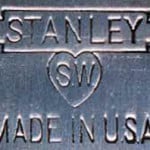Tool Rust Removal
Welcome! / Forums / General Woodworking Discussions / Tools and Tool Maintenance/Restoration / Tool Rust Removal
Tagged: electrolysis, evaporust, molasses, rust
- This topic has 33 replies, 19 voices, and was last updated 10 years, 3 months ago by
 Jay.
Jay.
-
AuthorPosts
-
Here’s my results from 4 weeks of soaking ax heads in molasses and water solution:
The carpenter’s hatchet head (with hammer end) was only moderately rusted and I further cleaned it with emery paper to polish it up (it was my father’s). The Keen Kutter, Argyle Birmingham, and un-branded head all had a heavy coating of rust which did come clean. I reground the edges of the Argyle head because it was badly misshapen from someone using the eye end to hammer with.
The Keen Kutter/Simmon’s brand and the unbranded head are just as they came out of the solution and washed only (unbranded starting to pick up rust from air already). Nice gray metal and you may be able to see where the hard edge metal is welded to the tip of the blades. There is a visible line there and color difference.
So the Pros are these:
Green method, no electricity, no chemicals, didn’t damage tools, does an efficient job.
The Cons are these:
Takes at least 4 weeks to get a result, surface of container scums up and smells awfully bad around week 3 or so. Don’t use in the house unless you don’t mind a really strong unpleasant odor.
If you try this method: Tools must be washed clean as soon as they come out of the bath and some kind of coating applied (oil etc.) or else rusting from air moisture takes hold again right away. Hope this information helps.
Joe B.
Attachments:
You must be logged in to view attached files.
Thanks for the results of your experiment, Joe.
Another rust removal method that I can’t believe I didn’t mention is a buffing wheel and greaseless compound. I probably use my buffing wheel more than any power tool, and I have used it for antiques, straight razors, etc… I used it last night on a vintage block plane with light rust… it went to no rust and a brilliant polish in a matter of a few minutes.

No problem, Joe. Of the rust removal methods, it’s the only one I can think of that takes a little practice… but very little. Anyone who is used to using tools can easily do it. Just get a couple practice pieces of metal to get the feel for it… takes a light touch… then you are good to go. Caswell is a great source for supplies.
-
AuthorPosts
- You must be logged in to reply to this topic.
